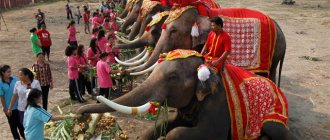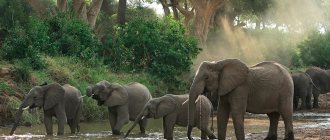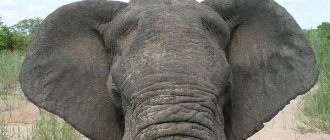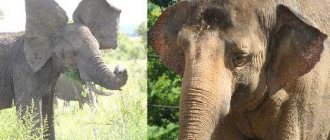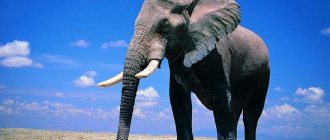The elephant is a unique animal. Its difference from other mammals is so great that scientists have assigned it to a separate order - proboscis, which contains only 2 species.
The main thing you immediately notice is the huge size of the elephant. This is the largest living animal on Earth.
Now only two species of elephants remain in nature: African and Indian.
Many people wonder: how much does an elephant weigh?
The height of the Indian elephant from the ground to the withers is approximately 2-2.5 meters, and the weight ranges from 3 to 5 tons.
The African elephant is much larger than its relative. It weighs 6-7 tons, and its height reaches 4 meters. There are also larger African elephants - real giants, with a body weight of 10-11 tons.
Elephant - description and characteristics
The majestic animal has practically no enemies and does not attack anyone, being a herbivore. Today they can be found in the wild, in national parks and reserves, in circuses and zoos, and there are also domesticated individuals. A lot is known about them: how many years elephants live, what elephants eat, how long an elephant’s pregnancy lasts. And yet secrets remain.
How much does an elephant weigh?
This animal cannot be confused with any other, since hardly any land mammal can boast of such dimensions. The height of this giant can reach up to 4.5 meters, and its weight can reach up to 7 tons. The largest is the African savannah giant. Indian counterparts are somewhat lighter: weight up to 5.5 tons for males and 4.5 tons for females. Forest elephants are considered the lightest - up to 3 tons. In nature, there are also dwarf varieties that do not reach 1 ton.
Elephant skeleton
The elephant's skeleton is strong and allows it to withstand such an impressive weight. The body is massive and muscular.
The animal's head is large, with a protruding frontal area. Its decoration is its movable ears, which serve as a heat regulator and a means of communication between fellow tribesmen. When attacking a herd, the animals begin to actively move their ears, scaring off enemies.
The legs are also unique. Contrary to the popular belief that animals are noisy and clumsy, these giants walk almost silently. The feet have thick fat pads that soften the step. A distinctive feature is the ability to bend its knees; the animal has two kneecaps.
The animals have a small tail ending in a non-furry brush. Usually the cub holds on to it in order to keep up with the mother.
Elephant trunk
A distinctive feature is the elephant's trunk, the mass of which in an elephant can reach up to 200 kg. This organ is a fused nose and upper lip. Consisting of more than 100 thousand strong muscles and tendons, the elephant's trunk has incredible flexibility and strength. They use it to pick off vegetation and put it in their mouth. Also, the elephant's trunk is a weapon with which it defends itself and fights its opponent.
The giants also draw in water through their trunks, which they then put into their mouths or pour over. Elephants up to one year old have little control over their proboscis. For example, they cannot drink with it, but kneel down and drink with their mouth. But they hold tightly to their mother’s tail with their trunk from the first hours of their life.
Elephant vision and hearing
Relative to the size of the animal, the eyes are small, and these giants do not differ in acute vision. But they have excellent hearing and are able to recognize sounds even at very low frequencies.
It is believed that animals hear thunder at a distance of up to 100 km and can accurately locate water located at a great distance by noise.
Leather
The body of a large mammal is covered with thick gray or brown skin, mottled with many wrinkles and folds. Sparse hard bristles on it are observed only in cubs. In adults it is practically absent.
The color of the animal directly depends on its habitat, since elephants often sprinkle themselves with earth and clay to protect themselves from insects. Therefore, some representatives appear brown and even pink.
Among giants, albinos are very rare, but still found. Such animals are considered iconic in Siam. White elephants were taken specifically for royal families.
Jaws
The decoration of the giant is its tusks: the older the animal, the longer they are. But not everyone is the same size. The female Asian elephant, for example, is completely devoid of such decorations by nature, just like rare males. The tusks fit into the jaws and are considered incisors.
How many years an elephant lives can be determined by its teeth, which wear down over the years, but at the same time new ones appear, growing behind the old ones. It is known how many teeth an elephant has in its mouth. As a rule, 4 radicals.
It was the tusks of these giants that were very highly valued, which led to the brutal extermination of proboscideans. Now hunting is strictly prohibited: the animal is listed in the Red Book. And the places where the elephant lives are declared nature reserves.
The Indian elephant and the African elephant have external differences, we will talk about them in the sequel.
Physiological features
African savanna elephants have longer legs, which is most likely due to living in open areas and their feeding habits, because their main food is succulent leaves on the tops of trees and bushes. But Asian elephants, which feed on grass and greenery from the lower tiers of the forest, have shorter legs. There are also differences in the structure of the skeleton: African elephants have 21 pairs of ribs, while Indian elephants have 19. Female African savannah elephants are able to bear offspring only after reaching 25 years of age, but Asian elephants become mothers for the first time at the age of 15-20.
Types of elephants
Nowadays, there are only two species of proboscis: the African elephant and the Indian elephant (otherwise known as the Asian elephant). African ones, in turn, are divided into savannahs living along the equator (the largest representatives are up to 4.5 m in height and 7 tons of weight) and forest ones (its dwarf and swamp subspecies), which prefer to live in tropical forests.
Despite the undeniable similarity of these animals, they still have a number of differences.
- It is very simple to answer the question of which elephant is larger in size and weight: Indian or African. The one that lives in Africa: individuals weigh 1.5-2 tons more, and are much taller.
- The female Asian elephant does not have tusks; all African elephants have tusks.
- The species differ slightly in the shape of the body: the Asian ones have a higher rear part relative to the level of the head.
- The African animal is distinguished by its large ears.
- The trunks of African giants are somewhat thinner.
- By its nature, the Indian elephant is more prone to domestication; it is almost impossible to tame its African counterpart.
It is Asian animals that are often accepted into circuses for their obedience and good disposition. Basically, these are sick and abandoned cubs rescued from poachers.
When crossing African and Indian proboscis, no offspring are obtained, which indicates differences at the genetic level.
The lifespan of an elephant depends on living conditions, the availability of sufficient food and water. It is believed that the African elephant lives somewhat longer than its counterpart.
Presence of tusks
Elephant tusks are modified upper incisors that are used by animals to obtain food and protect themselves from enemies. African savanna elephants, both females and males, have the largest tusks, the weight of which can reach 140 kilograms and a length of 3-4 meters. For Asian elephants, these figures are much more modest: 1.6 meters with a weight of 25 kilograms. It is worth noting that in Asian elephants only males have tusks, and even then not all of them. In Sri Lanka, for example, there is a population of elephants that have no tusks at all, even the males.
African savannah elephant skull
Ancestors of modern giants
Ancient relatives of proboscis appeared on earth approximately 65 million years ago, during the Paleocene era. At this time, dinosaurs still walked the planet.
Scientists have found that the first representatives lived on the territory of modern Egypt and were more like a tapir. There is another theory, according to which the current giants descended from a certain animal that lived in Africa and almost all of Eurasia.
Research revealing how long the elephant has lived on our planet points to the existence of its ancestors.
- Deinotherium. They appeared approximately 58 million years ago and died out 2.5 million years ago. Outwardly they were similar to modern animals, but were noted for their smaller size and shorter trunk.
- Gomphotherium. They appeared on earth approximately 37 million years ago and died out 10 thousand years ago. Their body resembled the current long-nosed giants, but they had 4 small tusks, twisted in pairs up and down, and a flat jaw. At some stage of development, the tusks of these animals became significantly larger.
- Mamutids (mastodons). Appeared 10-12 million years ago. They had dense hair on their body, long tusks and a trunk. They became extinct 18 thousand years ago, with the advent of primitive people.
- Mammoths. The first representatives of elephants. They appeared from mastodons approximately 1.6 million years ago. They became extinct about 10 thousand years ago. They were slightly taller than modern animals, their body was covered with long and dense hair, and they had large tusks hanging down.
Mammoths belong to the same order of elephants as modern giants.
The African elephant and the Indian elephant are the only representatives of the proboscis order existing on Earth.
Temperament and Taming
Asian elephants have a much more good-natured and flexible character than savannah elephants. They are easy to tame, and they show virtually no aggression towards people, which cannot be said about their large African counterparts. It is Asian elephants that perform in circus shows, help people with hard work in rural areas of Southeast Asia; in ancient times, trained elephants even took part in military battles. But although they tried to tame African elephants, they did not achieve much success. Moreover, safari tourists are always warned that a female elephant with a calf can be more dangerous than a pack of lions.
Where do elephants live?
The African elephant lives south of the Sahara Desert, in many African countries: Congo, Zambia, Kenya, Namibia, Somalia, Sudan and others. The fairly hot climate of the places where the elephant lives is to his liking. More often they choose savannas, where there is enough vegetation and water can be found. Animals practically do not enter deserts and impenetrable tropical forests.
Recently, the habitat of giants has decreased. Places where elephants live are turned into national reserves to preserve the population of these animals, protecting them from poachers.
But the Indian elephant, on the contrary, prefers forested areas of India, Vietnam, Thailand, China, Laos and Sri Lanka. He feels comfortable among dense bushes and thickets of bamboo. This Asian elephant once lived in almost all areas of southern Asia, but now populations have declined greatly.
The Indian elephant can live even in inaccessible jungles. It is in this area that the largest number of wild specimens remain. But determining how many years an elephant lives can be quite difficult.
Elephant "Santa Barbara": it is important that there are no fights
Now, when this unfamiliar elephant walks around the habitat of several families, I clearly see how much larger the males are than the females.
“Oh my God,” Vicky gasps, “what a monster!”
An adult twenty-five-year-old elephant appears to be half the size of her gentleman.
“Look, look,” Vicky whispers, “she’s coming to say hello.”
They purr, their trunks intertwining for a moment. It is unlikely that she is in heat now - next to her is a baby elephant, which she is probably still feeding. Nevertheless, this elephant does not allow Vronsky to approach her.
Here the stranger freezes and, with some exaggerated carelessness, throws his giant trunk over his powerful tusk.
“This is so that the elephants understand that there is nothing to be afraid of.” It’s as if he’s telling them: “See how peaceful and calm I am. I came in like that, like a relative. I'm not scary." That’s what we call it: “drop in like a family,” Vicky smiles. — Of course, we just have a series about elephant life, “Santa Barbara,” which you will definitely get hooked on. I wonder who is having affairs with whom. So what should Vronsky do now?
How many years does an elephant live?
The lifespan of an elephant in the wild is significantly shorter than that of its domesticated counterparts or those living in zoos or national reserves. This is due to the difficult conditions of the places where the elephant lives, with diseases and the brutal extermination of giants.
Scientists are still debating how long a wild elephant lives and what their life expectancy is in captivity.
Undoubtedly, how many years an elephant lives is determined by the species to which the mammal belongs. African savannas live the longest: among them there are individuals whose age reached 80 years. African forest proboscideans are somewhat smaller - 65-70 years. An Asian elephant at home or in zoos and national parks can live 55-60 years; in the natural environment, animals that have reached 50 years of age are considered long-livers.
How long elephants live depends on how the animal is cared for. A wounded and sick animal will not be able to live long. Sometimes even minor damage to the trunk or foot causes death. Under human supervision, many diseases of giants can be easily treated, which can significantly prolong life.
In their natural environment, animals have practically no enemies. Predatory animals attack only stray cubs and sick individuals.
How an elephant finds a mate: the female is in heat, the male must be
Do animals experience emotions similar to humans? Are they capable of communication - the way we understand it? Observations of animals in several national parks allowed Karl Safina to write one of the most interesting books about our smaller brothers - if, of course, you can call elephants, wolves and killer whales that way. Did you know how elephants meet and have offspring?
What do elephants eat?
Being herbivores, proboscis spends more than 15 hours a day in search of food. To maintain their enormous body mass, they have to eat 40 to 400 kg of vegetation per day.
What elephants eat directly depends on their habitat: it can be grass, leaves, young shoots. The elephant's trunk picks them off and sends them into the mouth, where the food is thoroughly ground.
In captivity, the elephant eats hay (up to 20 kg per day), vegetables, especially carrots and cabbage, a variety of fruits, and grains.
How many years an elephant lives depends on what elephants eat. Zoo visitors often feed animals contraindicated food. Huge mammals are strictly prohibited from eating sweets.
Sometimes wild animals wander into the fields of local residents and happily eat the harvest of corn, cane, and grain.
Elephant lifestyle
The animals are very social: they form herds, led by the oldest and most experienced female. She takes her relatives to food places and keeps order.
Scientists have come to interesting conclusions. All individuals are relatives. As a rule, these are females and immature males. Grown-up boys leave their families and often live alone or in the company of similar bachelors. They approach family herds only when they are ready to have offspring and at the call of the females.
Animals have very developed family instincts: everyone has their own role. The whole family is involved in raising children. In the event of an attack by predators, the elephant calves are surrounded by a tight ring and the enemies are driven away. Unfortunately, how many years an elephant lives depends on whether the family was able to preserve all of its offspring. Babies quite often die from disease, weakness and from attacks by predators (lions, tigers, cheetahs, hyenas, crocodiles).
Giants require large amounts of water to survive. They can drink up to 200 liters per day, so the animals try to stay close to bodies of water. In dry times, they know how to dig wells, which saves not only themselves, but also many other animals.
Elephant mammals are very peaceful animals. Cases of them attacking other animals are extremely rare. They can only suffer from them when the giants, frightened by something, trample those who get in their way.
Before dying, old animals go to a certain place, the “elephant cemetery”, where many relatives died, and spend their last days there. The rest of the family sees them off and says a very touching goodbye.
Elephant breeding
Animals become sexually mature in different ways: males at the age of 14-15 years, females at 12-13.
Sometimes this age may vary depending on the amount of food and health status.
Several suitors come to the call of the female and her scent; they sometimes arrange fights, during which it is determined which male will remain. The elephant watches the contenders and after the end of the battle leaves with the winner. Elephants mating occurs away from the herd, after which the couple can walk together for several more days. Then the male leaves and the female returns to her family.
It’s quite interesting how long pregnant elephants walk. Elephants carry their cubs for quite a long time: 22-24 months. An elephant's gestation period is counted from the moment of mating. Pregnant females live with their herd, and males never appear nearby.
Compared to other mammals, elephant pregnancy lasts a record time: they carry their young for almost two years. The large size of females sometimes does not allow one to immediately discern their interesting position, so it is possible to calculate how long elephants have been carrying their cubs only from the moment of mating.
An elephant's pregnancy usually ends with the birth of one, or less often two, elephant calves, which weigh up to a hundredweight. The expectant mother leaves the herd, accompanied by an experienced female, and gives birth to a baby who, after 2-3 hours, can stand on his feet and suckle milk. A new mother returns to her herd with a baby elephant holding her tail.
Elephants carry their young for a very long time, so their populations, subject to severe extermination, have long been under threat of extinction.
How many years a male elephant lives in a herd is determined by the arrival of sexual maturity. Young males leave their families and live alone. But the females remain in the herd until the end of their days.
Pairing
Homosexual elephants, of which there are many, mate all year round, however, female elephants are only capable of conceiving a few days a year. At this time, males try to care for her, using various rituals in the form of affectionate gestures and snuggling. If she accepts the advances of one of them and reacts to all his tricks for about 20 minutes, then soon after the ritual they will begin to mate. If she becomes pregnant, she will carry her offspring for 22 months, the longest gestation process of any animal on earth.
Some elephants have the ability to self-medicate with the help of various plants. At birth, the cub weighs more than 100 kg. Elephants are four-legged animals, so unlike humans, they may have a relatively wider pelvis, making infant and maternal deaths rare, as well as birth complications. Baby elephants are born blind, and some of them suck their trunk after birth, much like a human baby sucks its thumb. The cubs that are born do not have the instincts to survive, so they are taught this by their mothers and other more experienced members of the herd. The mother selectively assigns several nannies to her baby because she now needs more time to eat well so that she can produce enough milk for her baby.
